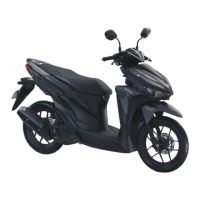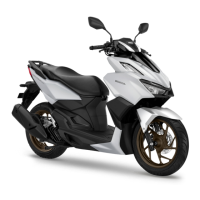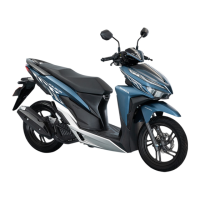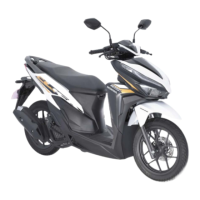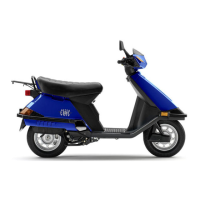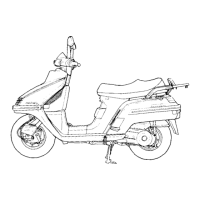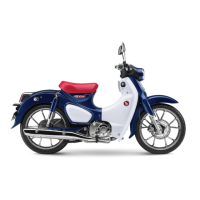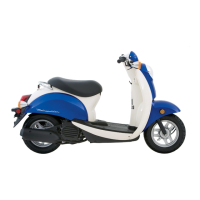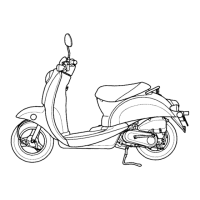Do you have a question about the Honda Click 125i 2017 and is the answer not in the manual?
Lists country codes used in the manual for identification purposes.
Guidelines for enhancing rider safety and operational procedures.
Precautions to take for safe riding and protective apparel.
Guidelines for safe operation, including running-in and braking.
Advice on adding accessories and making modifications to the scooter.
Guidelines for safely carrying loads and maximum weight capacity.
Overview of the scooter's basic operation sequence and features.
Identifies the location of various scooter parts and components.
Details the scooter's instrument panel, speedometer, and odometer.
Explains the function of various warning and indicator lights on the dashboard.
Describes the function and operation of various switches on the scooter.
Instructions on how to lock and unlock the rear brake.
Step-by-step guide on how to start the scooter.
Procedures for applying the front and rear brakes effectively.
Instructions on how to refuel the scooter safely and correctly.
Instructions on how to open and close the scooter's seat.
Location and usage of the helmet holders under the seat.
Information on the luggage box capacity and storage guidelines.
Lists the tools provided with the scooter for roadside repairs.
Location of the document bag for storing manuals and registration.
Information about the hook below the handlebar for carrying small items.
Location and load capacity of the glove boxes.
Explains why regular maintenance is essential for safety and performance.
Outlines the recommended maintenance intervals and tasks.
Basic principles and checks for performing maintenance tasks.
Details the tools provided with the scooter for maintenance and repairs.
Procedures for removing and installing major body components.
Instructions for checking and replacing the spark plug.
Guidelines for checking, adding, and changing engine oil.
Instructions for checking and adding coolant to the cooling system.
Procedures for checking front brake fluid, pads, and rear brake adjustments.
How to check the operation and safety features of the side stand.
Checking the throttle operation and freeplay for smooth acceleration.
Procedure for cleaning the crankcase breather tube.
Instructions for adjusting the headlight aim according to regulations.
Solutions for when the starter motor operates but the engine doesn't start.
Steps to take when the engine overheats or the temperature indicator is on.
What to do if the PGM-FI indicator light comes on during riding.
How to interpret and address fuel gauge errors or blank displays.
Information on tyre repairs and emergency procedures.
Steps to take when the scooter battery is dead or needs charging.
Procedures for replacing various burned-out light bulbs on the scooter.
How to locate and replace blown fuses in the fuse box.
Troubleshooting steps for intermittent engine operation issues.
Information on ignition keys, key numbers, and spare keys.
Details on ignition switch, odometer, and document bag.
Guidelines for cleaning, polishing, and protecting the scooter.
Instructions for properly storing the scooter for extended periods.
Safe methods and precautions for transporting the scooter.
Advice on environmentally friendly cleaning and waste disposal.
Location and importance of frame and engine serial numbers.
Information on using fuels with alcohol content and potential damage.
Guidelines to protect the scooter's catalytic converter.
Key physical dimensions and weight specifications of the scooter.
Technical data including tyre sizes, pressures, and recommended fluids.
Specifications for all light bulbs used on the scooter.
Ratings for the main and other fuses used in the scooter's electrical system.
Important torque values for engine oil drain bolt and oil plug.
Lists country codes used in the manual for identification purposes.
Guidelines for enhancing rider safety and operational procedures.
Precautions to take for safe riding and protective apparel.
Guidelines for safe operation, including running-in and braking.
Advice on adding accessories and making modifications to the scooter.
Guidelines for safely carrying loads and maximum weight capacity.
Overview of the scooter's basic operation sequence and features.
Identifies the location of various scooter parts and components.
Details the scooter's instrument panel, speedometer, and odometer.
Explains the function of various warning and indicator lights on the dashboard.
Describes the function and operation of various switches on the scooter.
Instructions on how to lock and unlock the rear brake.
Step-by-step guide on how to start the scooter.
Procedures for applying the front and rear brakes effectively.
Instructions on how to refuel the scooter safely and correctly.
Instructions on how to open and close the scooter's seat.
Location and usage of the helmet holders under the seat.
Information on the luggage box capacity and storage guidelines.
Lists the tools provided with the scooter for roadside repairs.
Location of the document bag for storing manuals and registration.
Information about the hook below the handlebar for carrying small items.
Location and load capacity of the glove boxes.
Explains why regular maintenance is essential for safety and performance.
Outlines the recommended maintenance intervals and tasks.
Basic principles and checks for performing maintenance tasks.
Details the tools provided with the scooter for maintenance and repairs.
Procedures for removing and installing major body components.
Instructions for checking and replacing the spark plug.
Guidelines for checking, adding, and changing engine oil.
Instructions for checking and adding coolant to the cooling system.
Procedures for checking front brake fluid, pads, and rear brake adjustments.
How to check the operation and safety features of the side stand.
Checking the throttle operation and freeplay for smooth acceleration.
Procedure for cleaning the crankcase breather tube.
Instructions for adjusting the headlight aim according to regulations.
Solutions for when the starter motor operates but the engine doesn't start.
Steps to take when the engine overheats or the temperature indicator is on.
What to do if the PGM-FI indicator light comes on during riding.
How to interpret and address fuel gauge errors or blank displays.
Information on tyre repairs and emergency procedures.
Steps to take when the scooter battery is dead or needs charging.
Procedures for replacing various burned-out light bulbs on the scooter.
How to locate and replace blown fuses in the fuse box.
Troubleshooting steps for intermittent engine operation issues.
Information on ignition keys, key numbers, and spare keys.
Details on ignition switch, odometer, and document bag.
Guidelines for cleaning, polishing, and protecting the scooter.
Instructions for properly storing the scooter for extended periods.
Safe methods and precautions for transporting the scooter.
Advice on environmentally friendly cleaning and waste disposal.
Location and importance of frame and engine serial numbers.
Information on using fuels with alcohol content and potential damage.
Guidelines to protect the scooter's catalytic converter.
Key physical dimensions and weight specifications of the scooter.
Technical data including tyre sizes, pressures, and recommended fluids.
Specifications for all light bulbs used on the scooter.
Ratings for the main and other fuses used in the scooter's electrical system.
Important torque values for engine oil drain bolt and oil plug.
| Displacement | 124.9 cc |
|---|---|
| Bore x Stroke | 52.4 x 57.9 mm |
| Max Torque | 10.8 Nm @ 5, 000 rpm |
| Fuel System | PGM-FI (Programmed Fuel Injection) |
| Ignition System | Full Transistorized Ignition |
| Starting System | Electric |
| Front Suspension | Telescopic fork |
| Rear Suspension | Unit swing |
| Front Brake | Disc brake |
| Rear Brake | Drum brake |
| Front Tire | 80/90-14M/C 40P |
| Rear Tire | 90/90-14M/C 46P |
| Overall Width | 679 mm |
| Wheelbase | 1, 280 mm |
| Seat Height | 769 mm |
| Ground Clearance | 135 mm |
| Engine Type | 4-stroke |
| Max Power | 8, 500 rpm |
| Transmission Type | V-Matic |
| Fuel Tank Capacity | 5.5 L |
